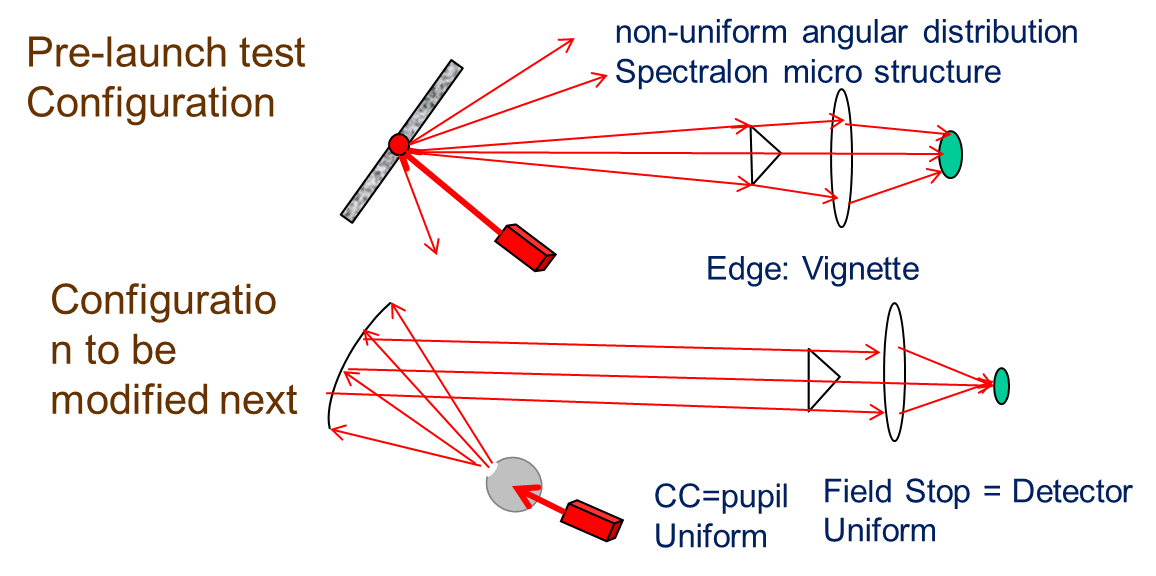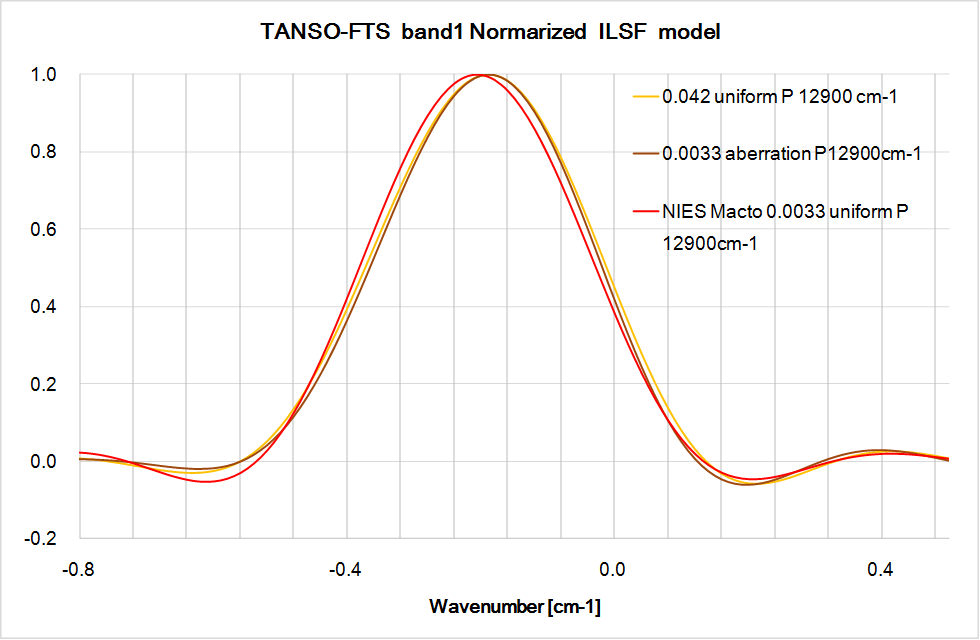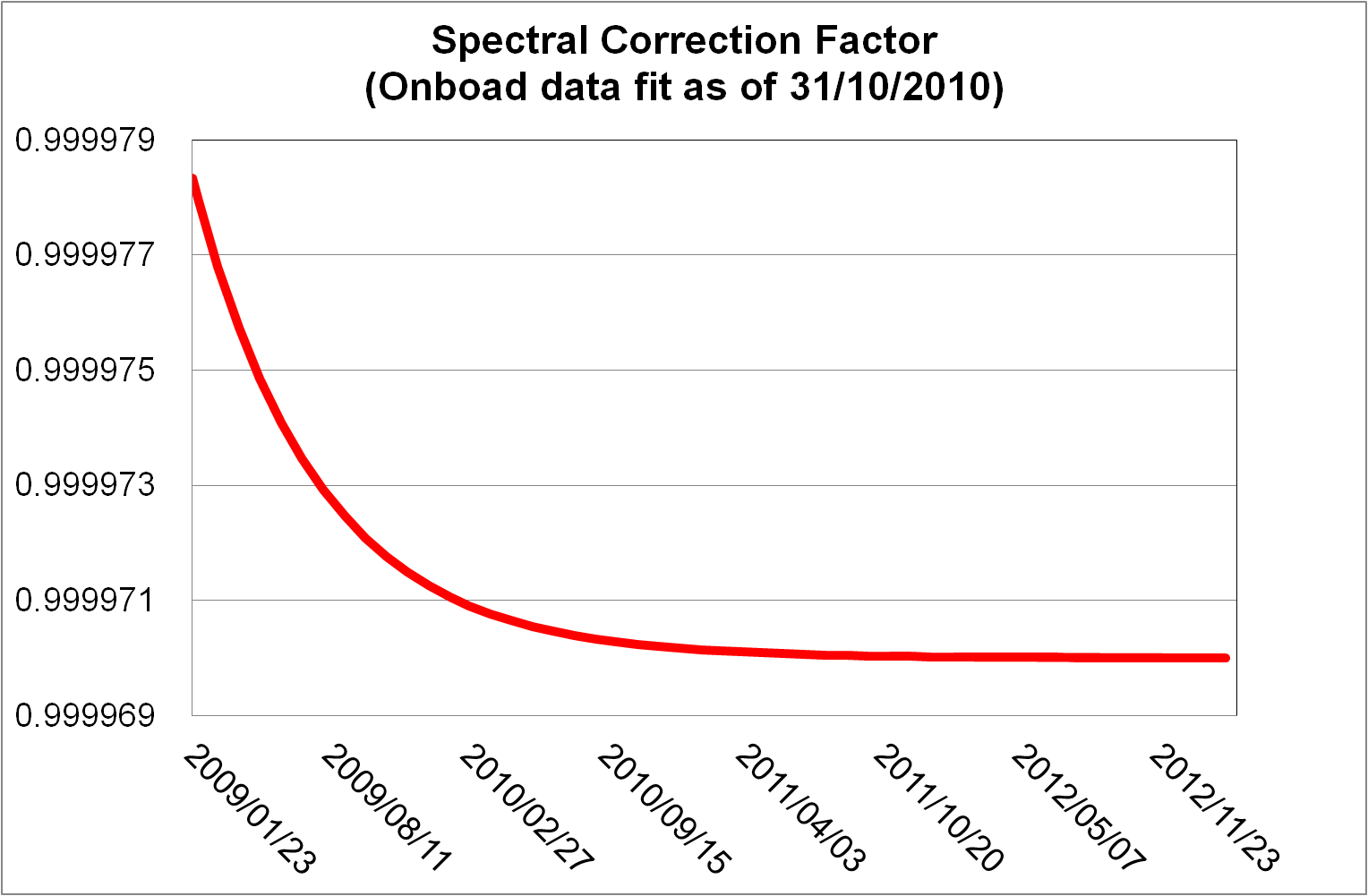Pre-launch calibration and simulated model
The geophysical parameters are retrieved by comparing the measured spectral radiance and the simulated radiance at the top of the atmosphere.  ,
,  , and other geophysical parameters, such as surface pressure, can be retrieved by minimizing the residual between the measured spectrum and simulated spectrum convolved with the instrument line shape function (ILSF). Because the instrument line shape function (ILSF) is a function of the wavelength, ILSFs at selected wavelengths are modeled and released from NIES GDAS. The models are simulated because the pre-launch tests with monochromatic light from tunable diode lasers were performed at limited wavenumbers and did not cover the whole spectral range. Off-axis mounting of the detector due to imperfect alignment creates an asymmetry of ILSF: however, this effect can be numerically simulated. The ILSF at short wavelengths is more sensitive to the misalignment, thus the detector position during the integration has to be accurately measured. Misalignment from the ideal optical axis of the Band 1P and 1S are estimated by introducing monochromatic light from a tunable diode laser prior to launch. Spatial uniformity over the scene aperture and angular uniformity over the entire IFOV are particularly important for this characterization. Although the pre-launch test configuration was imperfect, nevertheless the data contains detector offset information. By carefully simulating the imperfect pre-launch test configuration, the offset value was estimated and the band 1 model was modified a few times as mentioned below. The best estimate ILSF models were calculated using the offset value and optical aberration. On the other hand, for bands 2, 3, and 4, ILSF are much less sensitive to the misalignment of the detector, and being less than 50 µm, the finite size effect of IFOV has been considered.
, and other geophysical parameters, such as surface pressure, can be retrieved by minimizing the residual between the measured spectrum and simulated spectrum convolved with the instrument line shape function (ILSF). Because the instrument line shape function (ILSF) is a function of the wavelength, ILSFs at selected wavelengths are modeled and released from NIES GDAS. The models are simulated because the pre-launch tests with monochromatic light from tunable diode lasers were performed at limited wavenumbers and did not cover the whole spectral range. Off-axis mounting of the detector due to imperfect alignment creates an asymmetry of ILSF: however, this effect can be numerically simulated. The ILSF at short wavelengths is more sensitive to the misalignment, thus the detector position during the integration has to be accurately measured. Misalignment from the ideal optical axis of the Band 1P and 1S are estimated by introducing monochromatic light from a tunable diode laser prior to launch. Spatial uniformity over the scene aperture and angular uniformity over the entire IFOV are particularly important for this characterization. Although the pre-launch test configuration was imperfect, nevertheless the data contains detector offset information. By carefully simulating the imperfect pre-launch test configuration, the offset value was estimated and the band 1 model was modified a few times as mentioned below. The best estimate ILSF models were calculated using the offset value and optical aberration. On the other hand, for bands 2, 3, and 4, ILSF are much less sensitive to the misalignment of the detector, and being less than 50 µm, the finite size effect of IFOV has been considered.

The ILSF test configuration at pre-launch and the ideal one.

Band 1P ILSF models updates history
- The version released from NIES GUIG in 2009 assumed the detector offset of 0.042 degrees and no optical aberration. The offset of 0.042 degrees is equivalent of 40 micron, which is too large considering alignment budget in the detector integration. As the above figure shows, the prelaunch test configuration has non-uniformity problem. Therefore the offset effect was overestimated.
- The second version was released by request in 2011. This version considered the optical aberration. The estimated offset was 0.0033 degrees, which was much smaller than the value of the 2009 version.
- The version released from NIES GUIG in 2015 uses the same offset value of 0.0033 degrees as 2011. But the optical aberration has not been considered any more as the optical aberration was calculated by optical simulation and the complicated simulation has large errors.
Spectral resolution on orbit
ILSF symmetry represents spectral resolution and alignment of the optics. A monochromatic 1.55 µm diode laser is mounted on the outer structure of the optics unit and illuminates the diffuser plate. It provides ILSF calibration only for bands 2P and 2S. As all TANSO-FTS bands share the common circular stop and the aft optics are rigidly mounted, the on-orbit ILSF of bands 1, 3, and 4 can be estimated.
The figure shows the long term stability of the data using the onboard ILSF calibration laser which has a 6460 cm-1 frequency. Although the frequency of the onboard diode laser without temperature control is not constant and the laser cannot illuminate the solar diffuser plate uniformly, the ILSF shape itself has been very stable since launch: this indicates that no significant spectral resolution change has been observed.

Overwritten ILSF acquired monthly on orbit from Mar. 2009 to Apr. 2010 using the onboard diode laser which has 6460 cm-1 frequency.
Absolute spectral calibration
By carefully monitoring sampling laser output level of the FTS mechanism and the solar Fraunhofer line positions, we have observed a gradual decrease of the laser signal detection level and an increase of the apparent wavenumber of the Fraunhofer lines. The degradation of the laser signal detection level is exponential and smaller than 10% in one year and is slowing down. We estimate that the laser will still have a sufficient level of control after 10 years of operation. We consider that the laser signal detection level decrease and the apparent increase in Fraunhofer wavenumber are related. Because all bands have the same spectral calibration factors, the most probable cause is a change in optical alignment of the laser beam on orbit. As a consequence, the illumination on the laser detector has become weaker, the maximum OPD has become larger, and the spectral resolution has become slightly higher. The absolute spectral position can be calibrated by applying the spectral correction factor with time:
 (1)
(1)
where  are wavenumbers before and after the correction, and
are wavenumbers before and after the correction, and  ,
,  ,
,  , and
, and  are the calibration coefficients and time from launch. The change since launch is less than 10 ppm and the effect on spectral resolution is negligibly small.
are the calibration coefficients and time from launch. The change since launch is less than 10 ppm and the effect on spectral resolution is negligibly small.

Spectral calibration factor as a function of days from launch.